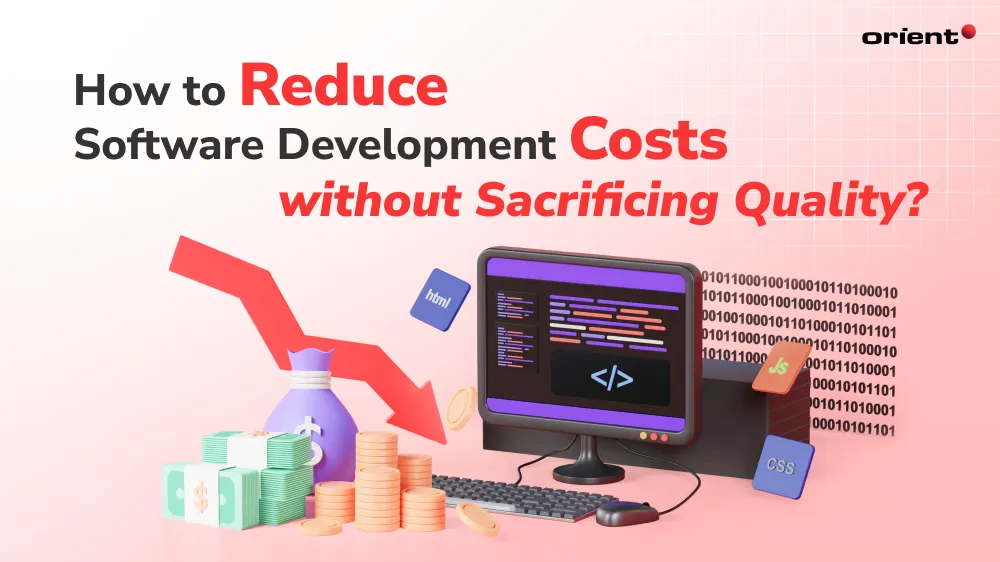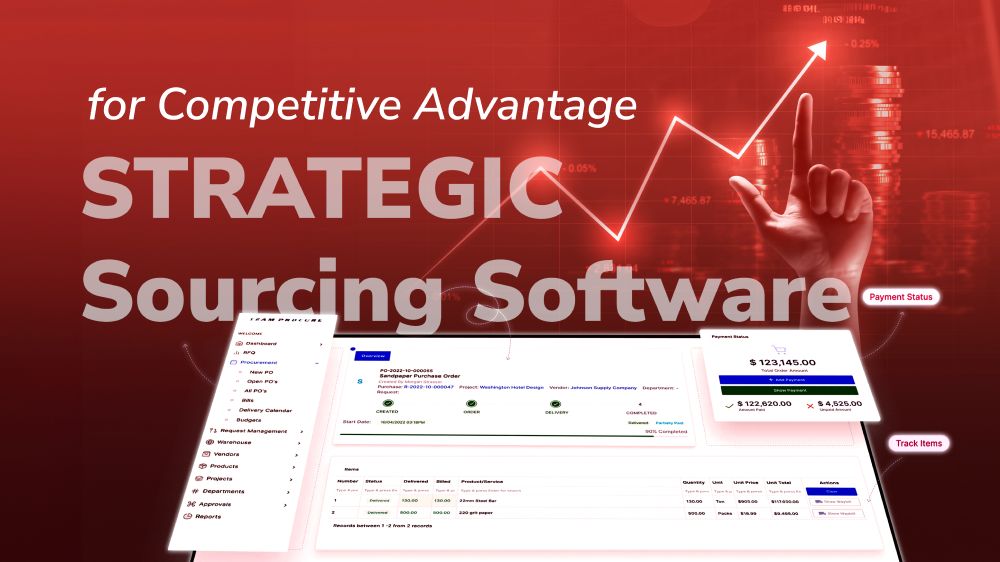How to Reduce Software Development Costs Without Sacrificing Quality?

Content Map
More chaptersSoftware development is the backbone of innovation, businesses are constantly seeking ways to cut costs and streamline processes. Yet, the challenge remains: how to reduce software development costs without compromising on quality?
As businesses increasingly go digital, the demand for software projects and developers continues to rise. However, the cost of developing software can be daunting, ranging from $3,000 to $150,000 and even up to $1 million for complex designs. Despite these figures, businesses are extremely concerned when up to 45% of software projects surpass their budget during deployment.
In this guide, we will delve into innovative approaches and proven strategies that can help your business achieve cost-effective software solutions. Whether you’re a small startup or a large enterprise, the insights presented here will equip you with the knowledge to make informed decisions and achieve greater cost-efficiency in your software development projects.
Key Takeaways:
- Consider outsourcing for specific tasks, leverage open-source libraries and frameworks, and develop an MVP to gain user feedback early. These strategies can significantly reduce development time and costs while fostering innovation.
- Clearly define project scope, prioritize features based on user needs, and leverage Agile methodologies to adapt and iterate effectively. This ensures you’re building the right software, avoiding wasted development effort on unnecessary features.
- Invest in a robust QA process with a focus on early bug detection and preventative measures like code reviews. This minimizes costly rework and ensures you deliver a high-quality product that builds trust and user satisfaction.
Leveraging Outsourcing Services
One of the most effective approaches to reducing software development costs without compromising quality is to leverage outsourcing services. By tapping into the external software development teams expertise, organizations can access specialized skills and needed resources at a lower cost compared to investing in an in-house team.
Outsourcing software development offers several advantages that can contribute to significant cost savings. Firstly, outsourcing allows companies to tap into global talent pools, where developers in regions with a lower cost of living can provide their services at more competitive rates. According to a report by Deloitte, organizations that outsource can save up to 60% on software development costs.
Additionally, outsourcing services eliminate the need to invest in expensive in-house infrastructure for the development process, such as hardware, software licenses, and IT support. The outsourcing provider handles these overhead costs, allowing your enterprise to focus on its core business activities.
Moreover, outsourcing can improve project efficiency and reduce development timelines. Experienced outsourcing partners often have well-established processes, tools, and methodologies that streamline the development lifecycle, enabling faster turnaround times and more efficient project delivery.
When choosing an outsourcing partner, it’s crucial to prioritize quality over cost. Look for vendors with a proven track record of delivering high-quality software solutions, strong technical expertise, and a robust project management approach. Conducting thorough due diligence, checking references, and evaluating the outsourcing partner’s cultural fit with your organization can help ensure a successful and cost-effective outsourcing engagement.
One great choice for outsourcing software development is Orient Software. Orient Software is a well-established company with a proven track record in delivering high-quality software solutions. We have a development team of experienced developers who are skilled in a wide range of technologies. We also have strong project management practices, ensuring that your software project will be delivered on time and within budget. By choosing Orient Software, companies can reduce their software development costs while still achieving their business objectives.
Agile Development Methodology

Another effective approach to reducing software development costs is the adoption of the Agile methodology in the development cycle. Agile is a software development project management framework that emphasizes flexibility, collaboration, and continuous improvement, making it a powerful tool for optimizing development costs.
The Agile approach is designed to adapt to changing goals, requirements, and priorities throughout the development process. Unlike traditional Waterfall methodologies, which often lead to lengthy development cycles and rigid project plans, Agile promotes a more iterative and collaborative approach. This flexibility allows businesses to respond quickly to market changes, customer feedback, and evolving business needs, ultimately reducing the risk of costly rework or feature changes down the line.
By breaking down the project progress into smaller and manageable sprints, Agile teams can identify and address issues early on, avoiding the escalation of problems that can drive up development costs. Additionally, the emphasis on continuous integration and deployment in Agile enables organizations to release products or essential features more frequently, generating revenue and value for the business sooner.
At the heart of the Agile methodology is the concept of iterative development cycles, where the product is built and refined in incremental steps. This approach allows for regular feedback, testing, and adjustments, ensuring that the final product is well-aligned with the customer’s needs and expectations.
By implementing these iterative development cycles, organizations can benefit from several cost-saving advantages. Firstly, the feedback-driven nature of Agile helps identify and address issues early in the development process, preventing costly rework or delays later on. Secondly, the ability to make incremental changes and improvements based on user feedback reduces the risk of investing in features that may not be well-received or utilized, ultimately optimizing resource allocation.
Furthermore, the Agile approach encourages cross-functional collaboration and knowledge-sharing among team members, fostering a culture of continuous learning and improvement. This can lead to better efficiency and decision-making, and more effective problem-solving, all of which contribute to lower overall development costs.
Developing a Minimum Viable Product (MVP)
Developing a Minimum Viable Product (MVP) is a practical and strategic approach to reducing development costs in software projects. An MVP is the most basic version of the product that still delivers the core functionality and value proposition. It’s a product with just enough features and functionality to satisfy early adopters and provide feedback for future product development.
One of the primary ways an MVP helps reduce development costs is by limiting the scope of the project. By focusing only on the essential features, companies can significantly cut down on the time and resources required for development. This approach directly leads to a reduction in labor costs, as fewer developers are needed and the development timeline is shortened.
Another cost-saving benefit of developing an MVP is the ability to test the market quickly. By releasing the product early in the market, companies can gather meaningful feedback from real users. This feedback can guide future development and help avoid the costs associated with developing unwanted features.
Moreover, an MVP allows for risk mitigation. The financial risk associated with software development is high, particularly for startups and small businesses. By starting with an MVP, companies can validate their business idea early in the process and avoid the potentially high costs of failure.
Finally, an MVP provides an opportunity for early monetization. Even a simple product can solve a pressing problem for users. By solving this problem, companies can start generating revenue early in the process, which can be reinvested into further development.
Robust Quality Assurance and Testing

While cost reduction is a crucial consideration in software development, it’s essential to maintain a strong focus on quality assurance and testing to ensure the long-term success and reliability of the final product. Investing in robust quality assurance processes can ultimately result in cost savings by preventing costly defects, reducing the need for rework, and ultimately enhancing the overall user experience.
Quality assurance and rigorous testing are the cornerstones of delivering high-quality software. By implementing a comprehensive testing strategy, organizations can detect and address potential issues early in the development lifecycle, mitigating the risk of costly defects or failures that may arise later on. This proactive approach not only improves the product’s overall quality but also helps to minimize the need for expensive post-release maintenance and bug fixes.
To enhance efficiency and streamline the testing process, organizations should consider investing in automated testing tools. These powerful solutions can perform repetitive test cases, regression testing, and code analysis much faster than manual testing, freeing up valuable developer time and resources. Automated testing also ensures consistent and reliable results, lowering human error risks and improving the overall quality of the software.
In addition to automated testing, regular code reviews conducted by experienced developers can play a crucial role in maintaining software quality and reliability. These reviews help identify potential issues, best practices, and opportunities for optimization before the code is integrated into the codebase. By catching and addressing problems early, organizations can avoid the escalation of technical debt and the associated costs of rework or bug fixes down the line.
Furthermore, organizations should prioritize the implementation of robust quality assurance processes, such as continuous integration and deployment, to ensure the software’s reliability and stability. These practices help to detect and resolve integration issues, minimize the risk of system failures, and enable the seamless delivery of updates and new features.
Embracing Open-source Technologies
In the pursuit of reducing software development costs, organizations should strongly consider the adoption of open-source technologies. Open-source software and libraries offer a wealth of benefits that can significantly optimize development efficiency and costs.
The open-source community has contributed to a vast ecosystem of high-quality software, frameworks, and libraries that can be leveraged by development teams. These tools often provide robust functionality, extensive documentation, and active communities that contribute to their ongoing development and support. By incorporating open-source components into their projects, organizations can avoid the need to develop core functionality from scratch, saving valuable time and resources.
Open-source frameworks and tools can greatly accelerate the development process by providing pre-built solutions for common software challenges. These include web application frameworks, data processing libraries, security components, and more. By leveraging these open-source assets, development teams can focus their efforts on building tailored functionality that addresses the unique requirements of the project rather than reinventing the wheel.
Additionally, open-source technologies often benefit from continuous improvement and bug fixes that are contributed by the wider community. This means that organizations can access high-quality, well-maintained solutions without the burden of developing and maintaining them in-house, resulting in significant cost savings.
By combining the power of the above strategies with the expertise of a reliable software development partner, organizations can unlock significant cost savings, accelerate time-to-market, and deliver high-quality, reliable software solutions that address their unique business needs.







